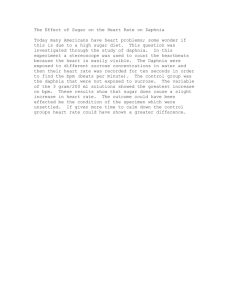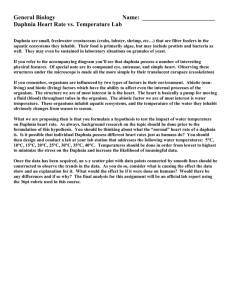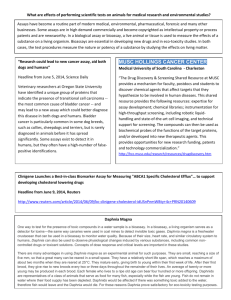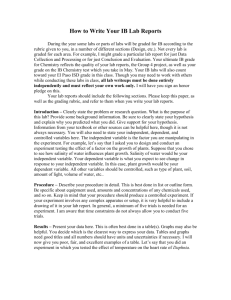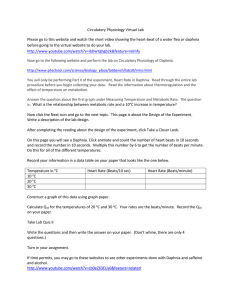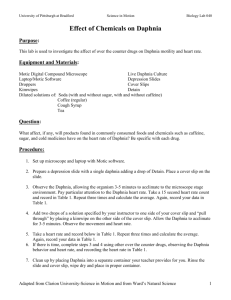Biology Introductory Research Project The Effects of Environmental
advertisement
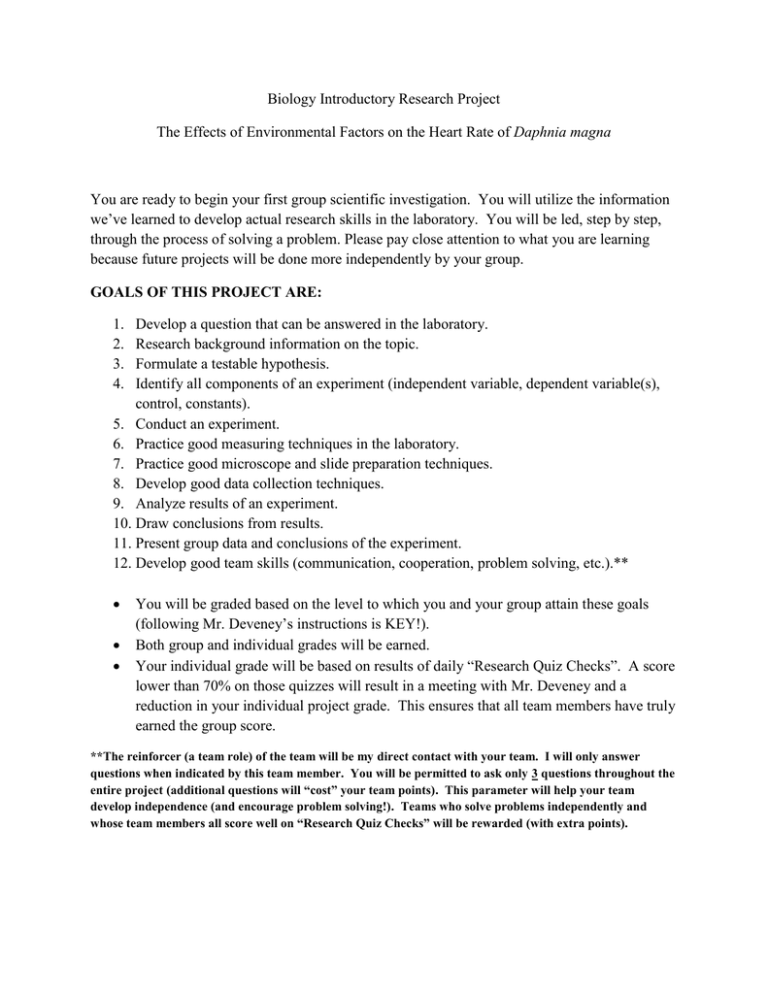
Biology Introductory Research Project The Effects of Environmental Factors on the Heart Rate of Daphnia magna You are ready to begin your first group scientific investigation. You will utilize the information we’ve learned to develop actual research skills in the laboratory. You will be led, step by step, through the process of solving a problem. Please pay close attention to what you are learning because future projects will be done more independently by your group. GOALS OF THIS PROJECT ARE: 1. 2. 3. 4. Develop a question that can be answered in the laboratory. Research background information on the topic. Formulate a testable hypothesis. Identify all components of an experiment (independent variable, dependent variable(s), control, constants). 5. Conduct an experiment. 6. Practice good measuring techniques in the laboratory. 7. Practice good microscope and slide preparation techniques. 8. Develop good data collection techniques. 9. Analyze results of an experiment. 10. Draw conclusions from results. 11. Present group data and conclusions of the experiment. 12. Develop good team skills (communication, cooperation, problem solving, etc.).** You will be graded based on the level to which you and your group attain these goals (following Mr. Deveney’s instructions is KEY!). Both group and individual grades will be earned. Your individual grade will be based on results of daily “Research Quiz Checks”. A score lower than 70% on those quizzes will result in a meeting with Mr. Deveney and a reduction in your individual project grade. This ensures that all team members have truly earned the group score. **The reinforcer (a team role) of the team will be my direct contact with your team. I will only answer questions when indicated by this team member. You will be permitted to ask only 3 questions throughout the entire project (additional questions will “cost” your team points). This parameter will help your team develop independence (and encourage problem solving!). Teams who solve problems independently and whose team members all score well on “Research Quiz Checks” will be rewarded (with extra points). The Effects of Environmental Factors on the Heart Rate of Daphnia magna TASK #1: (Team formation) Form your team and assign roles. Complete the project role sheet and put it in your team folder. This folder will remain in room 231 at all times. The reinforcer should complete and sign the “Reinforcer” sheet as the team is doing the project. TASK #2: (Research) Your team must research background information about Daphnia magna. (Use/complete the “Background Daphnia Questions” sheet.) Be sure that all bibliographical information is recorded so it can be cited properly! TASK #3: (Question Formation) Now that your team is an expert on the daphnia, you must decide what question you will answer in the laboratory. Daphnia magna will serve as a model in this activity. It may serve as a human model OR as an environmental model. Regardless of which your team chooses the question must have a logical rationale. A rationale is a reason for which you are answering the question. Human Model Daphnia magna can be exposed to any factor that may be ingested by humans and considered to affect the human heart. Environmental Model Daphnia magna can be exposed to any factor that may be released into its natural habitat to determine its effect on the organism. Brainstorm a list of possible questions/rationales here: Please circle circle the model your team has chosen. el Your team’s question: What is the effect of ____________________________________ on the heart rate of Daphnia magna? TASK #4: (Additional Research) Your team must research background information about your chosen environmental factor. Your team must know enough about your factor to form a testable hypothesis. Be sure that all bibliographical information is recorded so it can be cited properly! TASK #5: (Experimental Components) Identify the following components of this experiment: Independent variable:__________________________________ Levels of independent variable:__________________________ (if any) Dependent variable:___________________________________ Measures of dependent variable:_________________________ Control:____________________________________________ Constants:__________________________________________ TASK #6: Form a hypothesis and justify why you are making this prediction. Your hypothesis statement must include the independent and dependent variable. Hypothesis: Justification: This was hypothesized because TASK #7: (Experiment) **Remember to record all observations that your team makes as you are collecting data. Materials Daphnia magna culture petri dishes pipettes stopwatch paper felt tip marker microscope microscope slides beakers graduated cylinder Procedure 1. Prepare your variable solution(s)/environment. This part of the experiment is unique to your team. You must get this part of the procedure checked by Mr. Deveney________(√) 2. Set up a microscope with the low power objective in place. Obtain a clean microscope slide and transfer a daphnia onto the slide using a pipette. There should be enough water on the slide to keep the animal covered (but not too much that allows it to swim around!) 3. Observe the daphnia under low power, center it in the field of view, focus, and examine the entire animal. Locate the heart in the dorsal part of the animal. 4. Use a stopwatch to time the heart rate of the daphnia on your slide. The easiest way to count this fast beating is to use a felt tip pen to make a dot on a piece of paper for every heart beat and then count the dots. This allows you to count much faster. 5. Count the number of beats in 10 seconds and multiply by 6 to get beats per minute. 6. Record your results in the data table. Repeat and average the results. Place the “used” daphnia in the provided container. 7. Repeat the above procedure with daphnia that has received the experimental treatment. DO NOT REUSE THE SAME DAPHNIA. TASK #8: (Collect data) Heart rate of Daphnia magna (without environmental factor) Trial 1 _______ Trial 6______ Trial 2 _______ Trial 7______ Trial 3 _______ Trial 8 ______ Trial 4 _______ Trial 9 ______ Trial 5 _______ Trial 10______ Average Daphnia magna heart rate (without environmental factor): ________ Heart rate of Daphnia magna with ______________________ Trial 1 _______ Trial 6______ Trial 2 _______ Trial 7______ Trial 3 _______ Trial 8 ______ Trial 4 _______ Trial 9 ______ Trial 5 _______ Trial 10______ Average Daphnia magna heart rate with ______________________: ________ TASK #9: (Analyze) Sketch a rough draft of your team’s graph (on scratch paper) and have it checked by Mr. Deveney before preparing a final draft._______ (√) Graph your results. ***Remember, a graph illustrates your data in a meaningful way. Be sure to include a descriptive title and labeled X and Y axes. Your graph should be neat and selfexplanatory! TASK #10: (Draw conclusions) All answers should be in complete sentences. 1. What quantitative data did you collect? 2. What qualitative data did you collect? 3. According to the data you collected, what effect did your environmental factor have on the heart rate of Daphnia magna? 4. Make a conclusion statement. This statement should state whether or not your data supported your hypothesis. 5. List all controlled variables (constants) of your experiment. 6. What variables were not controlled? 7. How confident is your research team that your findings are reliable? (In other words, are you sure that your environmental factor was responsible for any effects you noted) Support your answer here: 8. If you could do this experiment again, what changes would you make to improve the project? Background Research on Team’s Environmental Factor
